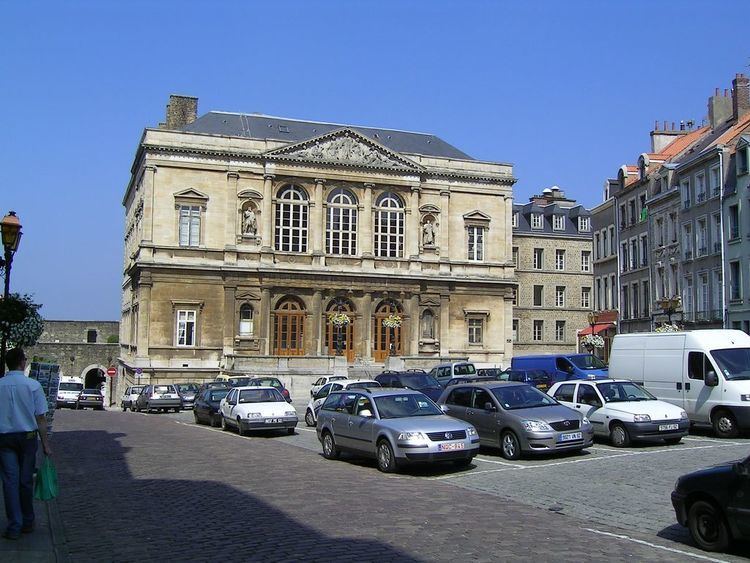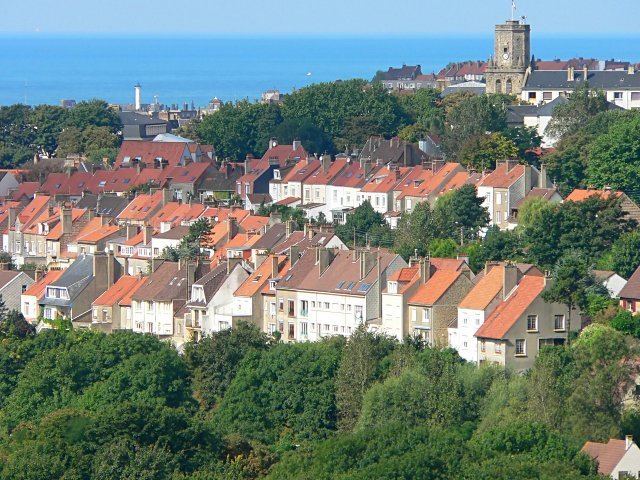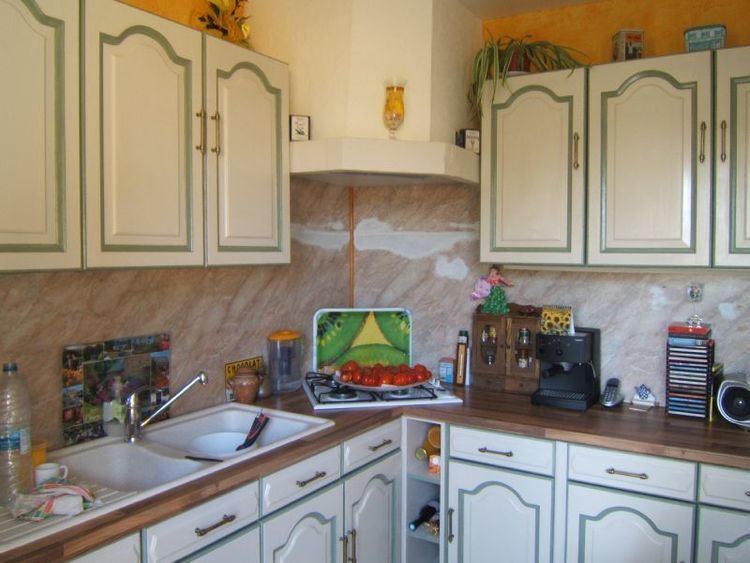Country France Area 42,785 Mayor Frederic Cuvillier (PS) | Region Nord-Pas-de-Calais | |
 | ||
Points of interest Nausicaa Centre National de la Mer, Basilica of Notre-Dame de Boulogne, Chateau de Boulogne-sur-Mer, Fort Mahon | ||
University Universite dete de Boulogne-sur-Mer | ||
Map of Boulogne-sur-Mer
Boulogne-sur-Mer ([bulɔɲsyʁmɛʁ], Latin: Gesoriacum or Bononia, Dutch: Bonen), often called Boulogne ( ), is a city in Northern France. It is a sub-prefecture of the department of Pas-de-Calais. Boulogne lies on the Côte d'Opale, a tourist coast on the English Channel, and is the most-visited location in its region after the Lille conurbation. Boulogne is its department's second-largest city after Calais, and the 60th largest in France. It is also the country's largest fishing port, specialising in herring.
Contents
- Map of Boulogne sur Mer
- Boulognesurmer cote dopale france walk faites une visite hd
- Suivez le guide boulogne sur mer la capitale de la cote d opale
- Name
- Location
- Transport
- Urbanization
- Climate
- Origin of the city
- Middle Ages
- The Napoleonic period
- The two world wars
- Sights
- Economy
- Media
- Events
- Administration
- Education
- University
- Public primary and secondary
- Private primary and secondary
- Health
- Sports
- Culture
- Food
- Born in Boulogne
- Others associated with Boulogne
- Twin towns Sister cities
- References

Boulogne was the major Roman port for trade and communication with Britain. After a period of Germanic presence following the collapse of the Empire, Boulogne was at the centre of the County of Boulogne of the Kingdom of France during the Middle Ages, and was occupied by the Kingdom of England numerous times due to conflict between the two nations. In 1805 it was a staging area for Napoleon's troops for several months during his planned invasion of the United Kingdom.

The city's 12th-century belfry is recognised by UNESCO as a World Heritage Site, while another popular attraction is the marine conservation centre Nausicaa.
Boulognesurmer cote dopale france walk faites une visite hd
Suivez le guide boulogne sur mer la capitale de la cote d opale
Name
The French name Boulogne derives from the Latin Bononia, which was also the Roman name for Bologna in Italy. Both places—and Vindobona (Vienna)—are thought to have derived from native Celtic placenames, with bona possibly meaning "foundation", "citadel", or "granary". The French epithet sur-Mer ("on-the-sea") distinguishes the city from Boulogne-Billancourt on the edge of Paris. In turn, the Boulogne in Boulogne-Billancourt originates from a church there dedicated to Notre-Dame de Boulogne, "Our Lady of Boulogne[-sur-Mer]".
Location
Boulogne-sur-Mer is in Northern France, at the edge of the Channel and in the mouth of the river "Liane". As the crow flies, Boulogne is approximately at 30 kilometres (19 miles) from Calais, 50 kilometres (31 miles) from Folkestone, 100 kilometres (62 miles) from Lille and Amiens, 150 kilometres (93 miles) from Rouen and 215 kilometres (134 miles) from Paris.
Boulogne is a relatively important city of the North, exercising an influence on the "Boulonnais" territory (74 towns and villages which surround Boulogne). The coast consists of important tourist natural sites, like the capes Gris Nez and Blanc Nez (which are the closest points of France to England), and attractive seaside resorts like Wimereux, Wissant, Hardelot and Le Touquet. The hinterland is mainly rural and agricultural.
Transport
Boulogne is close to the A16 motorway (Paris-Amiens-Calais-Dunkerque). Metropolitan bus services are operated by "Marinéo". The company Flixbus propose a bus line connecting Paris to Boulogne. There are coach services to Calais and Dunkerque.
The city has railway stations, which the most important is Boulogne-Ville station, located in the south of the city. Boulogne-Tintelleries station is used by regional trains. It is located near the university and the city centre. The former Boulogne-Maritime and Boulogne-Aéroglisseurs stations served as a boat connection (to England) for the railway.
Boulogne currently has no cross channel ferry services since the closure of the route to Dover by LD Lines in 2010.
The regional trains are TER Nord-Pas-de-Calais run by SNCF. The principal service runs from Gare de Boulogne-Ville via Gare de Calais-Fréthun, Gare de Calais-Ville to Gare de Lille-Flandres.
Urbanization
The city is divided into several parts :
Climate
Boulogne-sur-Mer has an oceanic climate that has chilly winters not far above freezing and cool summers tempered by its exposure to the sea. Considering its position, the climate is quite cold in relation to south and east coast locations in England year round. Precipitation is also higher than in said southern English locations.
Origin of the city
The foundation of the city known to the Romans as Gesoriacum is credited to the Celtic Boii. In the past,it was sometimes conflated with Caesar's Portus Itius, but that is now thought to have been a site near Calais which has since silted up. From the time of Claudius's invasion in AD 43, Gesoriacum formed the major port connecting the rest of the empire to Britain. It was the chief base of the Roman navy's Britannic fleet until the rebellion of its admiral Carausius in 286. As part of the imperial response, the junior emperor Constantius Chlorus successfully besieged it by land and sea in 293. The name of the settlement was changed to Bononia at some point between the sack of Gesoriacum and 310, possibly as a consequence of its refounding or possibly by the replacement of the sacked and lower-lying city by another nearby community.
The city was an important town of the Morini, and Zosimus called it Germanorum ("Germanic-speaking") at the end of the 4th century.
Middle Ages
In the Middle Ages Boulogne was the capital of an eponymous county, founded in the mid-9th century. An important Count, Eustace II, assisted William the Conqueror in his conquest of England. His wife founded the city's Notre Dame cathedral, which became a site of pilgrimage from the 12th century onwards, attended by fourteen French kings and five of England. It was an important whaling center prior to 1121. The city survived on herring fishing and received its municipal charter from Count Renaud of Dammartin in 1203.
The area was fought over by the French and the English, including several English occupations during the course of the Hundred Years War. Boulogne was again occupied by the English from 1544 to 1550. In 1550, The Peace of Boulogne ended the war of England with Scotland and France. France bought back Boulogne for 400,000 crowns. A culture of smuggling was present in the city until 1659, when French gains in Flanders from the Treaty of the Pyrenees moved the border northwards.
The Napoleonic period
Boulogne received its current status as a subprefecture of the Pas-de-Calais department in 1800 due to the territorial re-organisation in Revolutionary France. Three years later, it was given the title of an Imperial City (Ville Impériale).
The 19th century was a prosperous one for Boulogne, which became a bathing resort for wealthy Parisians after the completion of a railway line to the French capital. In the 19th century, the Basilica of Notre-Dame de Boulogne was reconstructed by the priest Benoit Haffreingue, who claimed to have received a call from God to reconstruct the town's ruined basilica. During the Napoleonic Wars, Napoleon amassed La Grande Armée in Boulogne to invade the United Kingdom in 1805. However, his plans were halted by other European matters and the supremacy of the Royal Navy.
A nephew of Bonaparte, Louis-Napoleon Bonaparte, later Napoleon III, returned to France in secret from his exile in England, passing through Boulogne in August 1840. He was later jailed for trying to lead a revolt in Strasbourg.
The two world wars
During the First World War, this was the debarkation port for the first unit of the British Expeditionary Force to land in France, and for many others thereafter.
Boulogne, was one of the three base ports most extensively used by the Commonwealth armies on the Western Front throughout the First World War. It was closed and cleared on 27 August 1914 when the Allies were forced to fall back ahead of the German advance, but was opened again in October and from that month to the end of the war, Boulogne and Wimereux formed one of the chief hospital areas.
Until June 1918, the dead from the hospitals at Boulogne itself were buried in the Cimetiere de L'Est, one of the town's cemeteries, the Commonwealth graves forming a long, narrow strip along the right hand edge of the cemetery. In the spring of 1918, it was found that space was running short in the Eastern Cemetery in spite of repeated extensions to the south, and the site of the new cemetery at Terlincthun was chosen.
It also was the site of an Allied (French and British) armaments production conference.
On 22 May 1940 during the Battle of France, two British Guards battalions and some pioneers attempted to defend Boulogne against an attack by the German 2nd Panzer Division. Despite fierce fighting, the British were overwhelmed and the survivors were evacuated by Royal Navy destroyers while under direct German gunfire. On 15 June 1944, 297 planes (155 Avro Lancasters, 130 Handley Page Halifaxes, and 12 De Havilland Mosquitos) of the Royal Air Force bombed Boulogne harbour to suppress German naval activity following D-Day. Some of the Lancasters carried Tallboy bombs, and as a result, the harbour and the surrounding area were completely destroyed. In August 1944 the town was declared a "fortress" by Adolf Hitler, but it succumbed to assault and liberation by the 3rd Canadian Infantry Division in September. In one incident, a French civilian guided the Canadians to a "secret passage" leading into the walled old town and by-passing the German defenders.
To replace the destroyed urban infrastructure, affordable housing and public facility projects in functional, brutalist building styles were carried out in the 1950s and 60s. The harbour, therefore, is not typical of a Northern French harbour.
Sights
Boulogne's 12th century belfry is one of 56 in northeastern France and Belgium with shared World Heritage Site status. It is the oldest building in the upper city, and currently serves as the home to a museum of Celtic remains from the Roman occupation. Founded as the Count's dungeon, the top floor was added in the 13th century. Damage by a fire in 1712 was built over by 1734.
Other than the belfry there are also the following sights:
Official website: Tourism in Boulogne sur Mer
Official website: Tourism in Boulogne sur Mer and the Boulonnais region
Economy
Boulogne-sur-Mer is an important fishing port, with 7,000 inhabitants deriving part, or all, of their livelihoods from fishing.
IFREMER (the French Research Institute for Exploitation of the Sea) and the Pasteur Institute are located in Boulogne Port.
Certain brands, including Crown and Findus, are based in Boulogne
Media
Events
In the year 1905 the First Esperanto Universal Congress was held in Boulogne-sur-Mer. L. L. Zamenhof, the creator of Esperanto, was among the attendees. In the 2005, there was a grand anniversary meeting, to mark the centenary, with more than 500 attendees.
Administration
Education
Boulogne-sur-Mer hosts one of the oldest Universités de l'été - summer courses in French language and culture. It is known as the Université d'été de Boulogne-sur-Mer.
The Saint-Louis building of the University of the Côte d'Opale's Boulogne campus opened its doors in 1991, on the site of the former St. Louis Hospital, the front entrance to which remains a predominant architectural feature. Its 6 major specialisms are Modern Languages, French Literature, Sport, Law, History and Economics. The university is situated in the town centre, about 5 minutes from the Boulogne Tintelleries railway station.
University
Public primary and secondary
Private primary and secondary
Health
Two health centres are located in Boulogne, the public Hospital Duchenne and the private Clinique de la côte d'opale.
Sports
Boulogne's football club, US Boulogne Côte d'Opale (US refers to Union Sportive), is one of the oldest in France due to the city's proximity to England, founded in 1898. The club currently play in the third tier, the Championnat National, and host home matches at the 14,500-capacity Stade de la Libération. Boulogne native and FIFA World Cup finalist Franck Ribéry began his career at the club.
Basketball teams in Boulogne include Stade Olympique Maritime Boulonnais and ESSM of Pro B (second-tier men's professional basketball league in France).
Culture
Food
As an international maritime port on the English Channel (La Manche), the town of Boulogne-sur-Mer has European and American influences in local cuisine. They include:
Born in Boulogne
Others associated with Boulogne
Twin towns — Sister cities
Boulogne-sur-Mer is twinned with:
